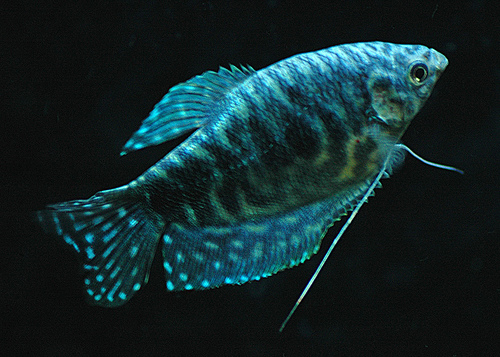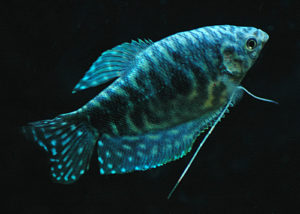
PRICE GUIDE
5cm: $8-$12
7cm: $12-$18

A popular tropical community fish available today is the beautiful Opaline Gourami. Their unique colouring and interesting behaviour makes them the ideal fish for a larger tropical freshwater community tank.
Common Name(s) : Opaline Gourami
Family : Osphronemidae
Genus: Trichopodus
Species : Trichopodus trichopterus
Origin : Southeast Asia and Indonesia
PH : 6.5 – 7.5
Hardness : Slightly Hard to Moderately Hard
Temperature : 23 – 28°C / 73–82°F
Maximum Size : 12cm / 4.8″
Lifespan : 5-6 years
Aggression Level : Low-Medium (3/10)
Recommended Tank Size : 65 Litres +
Strata : Top Half
TANK SET UP
Prefer a planted tank. Add some driftwood plants to help create their natural environment.
SUITABLE TANK MATES
- Most Large / Medium Tropical Fish
- Dwarf Cichlids
DIET
Omnivores, in the wild they eat insect larvae, crustaceans, zooplankton and plants. In the aquarium they will accept a wide range of foods including flake, small pellets, bloodworms and brine shrimp.
SEXING AND BREEDING
Female’s grow larger than males. A Gourami’s sex can be identified by the shape of the dorsal fin, which is long and pointed in males, compared to the female’s shorter rounded dorsal.
To breed them, condition a male and a female on some frozen food like bloodworm or brine shrimp for several weeks, when the female is gravid (fat with eggs) remove her from the community tank and move her into another tank with little or no filtration (you need very little water flow at the top of the water) and some plants – even add a cave or ornament for the possibility a scared female can retreat once the deed is done. Ensure the new tank has a lid – bubble nests require warm air for eggs to do well.
After a few days, add the male to the same tank. The male will begin to build a bubble nest on top of the water. Once he has finished he will seek her attention as they will ‘dance” together before he squeezes the eggs from the female. He fertilizes the eggs, he will then place the eggs into the bubble nest.
At this time you must carefully remove the female (being sure not to disturb the bubble nest) from the aquarium because she will be niaive and will eat the eggs (which ensures he will attack and maybe kill her for..) and leave the male in there (as he does all the caring for the eggs) for the next 24 hours – at which time the eggs will hatch.
Of the the 600-800 eggs, only a handful of fry will survive, they can be raised on baby brine shrimp until old enough to take flake food or other frozen foods.
OTHER USEFUL INFORMATION
Opaline Gourami are endemic in Indonesia and throughout southeast Asia. These fish live in marshes, swamps, canals, and lowland wetlands.
They migrate during the flood season from permanent water bodies to flooded areas, such as seasonally flooded forests in the middle and lower Mekong. During the dry season, they will return to these permanent water bodies.
Opaline Gourami’s are relatively large fish, growing to a maximum of 12cm. They are hardy and extremely easy to care for. As with all Gourami’s, they are egglayers and will build a bubble nest to breed.
This specimen features lovely patches – different from one specimen to another – blue-grey coloured body and features long thin pelvic fins that are effectively used as feelers. Two spots i hear you say.. well the eye is considered its third spot, silly I know.
Opaline Gourami’s possess a labryinth organ, which allows them to breath air directly from the surface as well as under the water. You will notice them constantly visiting the water’s surface to grab a gulp of air. In the wild, this allows them to live in swamps or pools of low water quality.
Opaline Gourami’s generally habitat the mid to top level of the aquarium.
